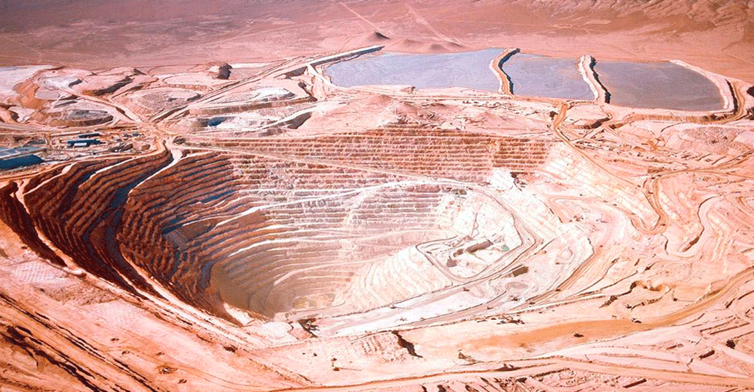Chile's Copper Production and Advancements
- Chile | 1st March 2023

Could Copper Become the New Oil? The red metal has historically served as an indicator of the global economy, but in recent years, a combination of diminishing physical stock, projected supply deficits, and strong long-term demand has propelled copper prices to record highs.
The decreasing trend in copper inventories at Comex, Shanghai, and LME warehouses since 2018 poses a threat to the supply. Although new production from upcoming projects like Teck Resources’ Quebrada Blanca 2 in Chile and Anglo American’s Quellaveco in Peru is expected to increase copper levels in 2023, a deficit is anticipated from 2025 onwards.
What sets the current situation apart is the challenge faced by the industry in quickly bringing projects into production. Speaking at the 2022 World Copper Conference, Erik Heimlich, head of base metals supply at CRU, suggested that over $100 billion must be invested in new developments to address an estimated annual supply deficit of 4.7 million tonnes by 2030. However, the likelihood of achieving this, equivalent to building eight projects the size of BHP’s Escondida mine, seems doubtful at best.
A report from Goldman Sachs on April 7th warned that the world is “sleepwalking towards a stockout,” signaling a significant shift in copper fundamentals. For the first time in a decade, copper stocks on exchanges declined in March instead of increasing during the metal’s usual surplus period. Considering copper’s essential role in the energy transition, the demand for copper is expected to rise. Ragnar Udd, BHP’s president of minerals Americas, stated that the world will require twice as much copper in the next 30 years as it has consumed in the previous 30 years. As the largest copper producer globally, Chile has a unique opportunity to leverage its resources for the benefit of its population and stakeholders involved in the copper value chain. However, seizing this opportunity requires substantial investment and streamlined development.
Chile, which accounts for more than a quarter of global copper output, experienced a production decrease of over 7% in January and February 2022 compared to the same months in the previous year, according to the Chilean Copper Commission (Cochilco). Although production is expected to rise in 2023 with the full-year production of QB2, the lack of major near-term projects in Chile’s copper pipeline underscores the need for urgent action. Delays in investment decisions caused by ongoing discussions surrounding the new constitution contribute to the inertia.
While there is ample capital available for ongoing investments, such as those by state-run Codelco, the world’s largest copper producer, the industry faces critical challenges. Codelco’s pre-tax profits reached $7.4 billion in 2021, with a total copper production of 1.728 million tonnes, including its stakes in Freeport’s El Abra and Anglo American’s Sur. Codelco’s current investments include the Rajo Inca expansion, extending the life of its Salvador operations until 2070. Antofagasta plc’s CEO, Iván Arriagada, discussed the Phase 1 expansion of the Los Pelambres project, set for completion in 2022. The expansion is designed to compensate for increasing ore hardness and is projected to increase annual copper production by an average of 60,000 tonnes over 15 years.
Freeport McMoRan, the third-largest copper producer globally, is working on ramping up production at its El Abra mine in Chile to pre-pandemic levels, aiming for a production range of 200 million to 250 million pounds per year. The company is constructing a new leach pad and focusing on reverting to a 24/7 operating schedule.
The demand for copper is increasing, and traditional means of production are no longer sufficient. Clayton Walker, Rio Tinto’s COO of copper, highlighted the opportunity for incremental production through reprocessing tailings deposits, which are estimated to contain around 100 million metric tons of copper globally. Amerigo Resources, through its Chilean subsidiary Minera Valle Central (MVC), has been capitalizing on this opportunity since 2003. By investing $300 million into the facility and doubling the capacity of its concentrator plant, Amerigo has increased its copper production from 25 million pounds per year to 63 million pounds in 2021. MVC works with Codelco’s El Teniente division to process fresh tailings and historical tailings deposits, extracting economic value from these environmental liabilities.
Under the leadership of Aurora Davidson, Amerigo has focused on improving margins and addressing water supply issues. The company announced record revenue in February 2022, prompting speculation about the potential to replicate this business model at other mines in Chile. Large mining development projects in Chile, such as Teck Resources’ Quebrada Blanca Phase 2 (QB2) and Antofagasta’s INCO development, have broader significance beyond production figures. These projects create opportunities for suppliers and support thousands of families reliant on the mining industry. QB2, set to begin production in the second half of 2022, is a significant step in Teck’s copper growth strategy, aiming to double consolidated copper production by 2023.
Capstone Copper’s Santo Domingo project is another notable development asset in Chile. Wheaton Precious Metals acquired a gold stream at Santo Domingo for $290 million, emphasizing the company’s commitment to maintaining strong relationships with its partners. The project’s scale and variety of metals make it an exciting prospect.
Overall, the increasing demand for copper and the need for innovative production methods present opportunities for companies like Amerigo Resources, while large mining development projects contribute to Chile’s mining ecosystem and local communities.








